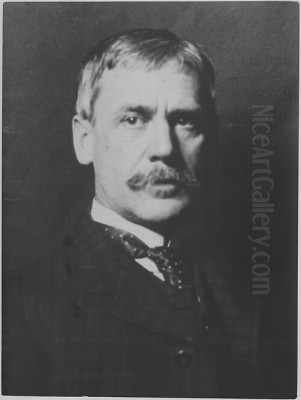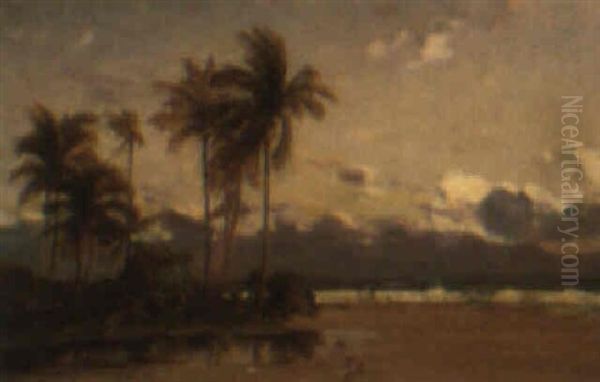
Peleg Franklin Brownell stands as a significant figure in the landscape of Canadian art history, recognized primarily as an accomplished Impressionist painter and an influential educator. Born in New Bedford, Massachusetts, USA, in 1857, his artistic journey led him to Canada, where he spent the majority of his prolific career, leaving an indelible mark on the nation's cultural development until his passing in Ottawa in 1946. His work, characterized by a sensitive handling of light and colour, bridged the academic traditions of his training with the fresh perspectives of Impressionism.
Early Life and Formative Training
Brownell's artistic inclinations emerged early, leading him to pursue formal training at the School of the Museum of Fine Arts, Boston. This initial education provided him with a solid foundation in drawing and painting techniques, grounded in the academic standards prevalent in North America at the time. However, like many ambitious artists of his generation, Brownell recognized the importance of experiencing the European art scene firsthand, particularly the vibrant artistic hub of Paris.
He traveled to Paris for several years, immersing himself in the city's dynamic artistic environment. Crucially, he enrolled in the prestigious Académie Julian and studied under renowned masters of the French academic tradition. His teachers included Tony Robert-Fleury, known for his historical compositions and portraits, and the highly celebrated William-Adolphe Bouguereau, a dominant figure in the official Salon whose polished, idealized figures were the epitome of academic finish. He also reportedly studied with Léon Bonnat, another leading portraitist and influential teacher. This rigorous training under figures like Bouguereau and Robert-Fleury instilled in him a mastery of draughtsmanship and composition.
While immersed in the academic system, Brownell was inevitably exposed to the revolutionary currents of Impressionism and Post-Impressionism that were challenging established norms in Paris. Although his own work would retain a strong sense of structure and form derived from his training, the Impressionist emphasis on capturing fleeting moments, the effects of light, and a brighter palette would profoundly influence his subsequent artistic development, particularly in his landscape painting.
A New Chapter in Canada: Montreal and Ottawa

Upon returning to North America, Brownell's path led him northward to Canada. He initially spent about a year teaching art in Montreal, a city with a burgeoning art scene. This period served as an introduction to the Canadian artistic community and landscape. However, his most significant contributions would be made in Ottawa, the nation's capital, where he relocated shortly thereafter.
In Ottawa, Brownell stepped into a position of considerable influence, becoming the Principal of the Ottawa Art School around 1886. He succeeded the previous head, Charles Moss, taking the helm of an institution founded in 1880 with the aim of fostering talent in fine arts and design within the capital region. The school, operating under the auspices of the Art Association of Ottawa, played a vital role in the city's cultural life, and Brownell's leadership would shape its direction for many years.
His tenure as Principal, which lasted until 1900, and his continued role as Headmaster until 1937, marked a long and dedicated commitment to art education in Ottawa. He was known as a demanding but respected teacher, guiding generations of students. His presence solidified the school's reputation and contributed significantly to the development of local artistic talent. Ottawa became his permanent home, the base from which he would build his career as both a painter and an educator.
Artistic Style: Embracing Impressionism
Peleg Franklin Brownell is best known as an early and important proponent of Impressionism in Canada. While his academic training provided a strong underpinning, his mature style reflects a clear engagement with Impressionist principles, particularly in his treatment of light and atmosphere. He moved away from the dark palettes and tight finish of purely academic work, embracing brighter colours and a more visible brushstroke to capture the transient effects of sunlight and weather.
His subject matter was diverse, encompassing landscapes, portraits, marine scenes, genre studies (scenes of everyday life), and floral still lifes. He worked proficiently in multiple media, including oil painting, watercolour, and possibly pastel or gouache (sometimes loosely referred to as 'acrylics' in older descriptions, though modern acrylics were not available during most of his career). Watercolour, in particular, allowed him to achieve effects of luminosity and spontaneity well-suited to Impressionist aims.
Brownell's landscapes often depict the Canadian scenery around Ottawa, the Gatineau Hills, and other locations he visited during his travels. He possessed a keen ability to observe and render the nuances of changing light across different seasons and times of day. His approach was less radical than some of the French Impressionists, often retaining a greater degree of structure and detail, but his focus on atmospheric effects places him firmly within the Canadian Impressionist movement alongside contemporaries like Maurice Cullen and Marc-Aurèle de Foy Suzor-Coté.
The Lure of Light: Travels to the West Indies
A particularly notable episode in Brownell's artistic journey was his trip to the British West Indies (specifically St. Kitts and Nevis) in 1911. He traveled there at the invitation of his friend Eric Brown, who was the first Director of the National Gallery of Canada. This journey proved immensely fruitful, exposing Brownell to an entirely different quality of light and a vibrant, tropical environment far removed from the Canadian landscape.
The intense sunlight, vivid colours, and unique cultural scenes of the Caribbean had a profound impact on his work. During this trip, he produced a significant body of over forty paintings and sketches. These works are characterized by their high-keyed palettes, brilliant light, and lively depictions of local landscapes, beaches, architecture, and daily life. They represent a distinct and highly regarded phase of his career, showcasing his ability to adapt his Impressionist techniques to capture the specific atmosphere of the tropics.
Works such as The Beach, St. Kitts (c. 1913), now in the collection of the National Gallery of Canada, exemplify this period. The painting captures the dazzling sunlight on the sand and water, the vibrant blue of the sea, and the relaxed figures enjoying the coastal setting, all rendered with energetic brushwork and a heightened sense of colour. These West Indies paintings were exhibited upon his return and were well-received, further cementing his reputation as a master of light and colour. His travels, which also included trips across Europe, the United States, and other parts of Canada, continually refreshed his vision and provided diverse subjects for his art.
Portraiture and Figurative Work
Alongside his celebrated landscapes, Brownell was also a skilled portrait painter. His academic training under masters like Bouguereau and Bonnat provided him with the technical proficiency required for capturing likenesses and conveying personality. He painted portraits of family members, prominent citizens of Ottawa, and other individuals throughout his career.
His portrait style often blended academic structure with Impressionist touches in the handling of light and background elements. While perhaps less experimental than his landscapes, his portraits were well-regarded for their sensitivity and craftsmanship. A work sometimes mentioned, perhaps Portrait of Mrs. Franklin Brownell or similar studies of figures often incorporating still life elements like flowers in a vase, demonstrates his ability to combine genres and showcase his skill in rendering textures, light on fabric, and the subtleties of human expression within an intimate setting.
His figurative work extended beyond formal portraits to include genre scenes, depicting ordinary people engaged in daily activities. These works, particularly some inspired by his travels, allowed him to explore narrative elements and capture candid moments, often infused with the same attention to light and atmosphere found in his landscapes.
Leadership in the Arts Community
Brownell's influence extended well beyond his personal artistic output and his role at the Ottawa Art School. He was deeply involved in the broader Canadian art community and held significant leadership positions. His commitment to fostering art appreciation and supporting fellow artists was evident throughout his career.
He was an active member of the Royal Canadian Academy of Arts (RCAA), a prestigious body founded in 1880 to promote the visual arts in Canada. Brownell was elected to the RCAA in 1895 and later served as its President from 1912 to 1915. This position placed him at the forefront of the national art scene, advocating for Canadian artists and contributing to the organization's exhibitions and policies. His leadership within the RCAA underscores the high esteem in which he was held by his peers.
Furthermore, Brownell played a key role in the founding and leadership of the Women's Art Association of Ottawa. This organization provided crucial support, exhibition opportunities, and educational programs for female artists in the region at a time when their access to the mainstream art world could be limited. His involvement highlights a progressive attitude and a dedication to nurturing artistic talent across the community. His long career in Ottawa made him a central and respected figure in the city's cultural development.
Connections and Contemporaries
Brownell's long career placed him in contact with numerous artists, educators, and administrators who shaped Canadian art in the late 19th and early 20th centuries. His teachers in Paris – William-Adolphe Bouguereau, Tony Robert-Fleury, and Léon Bonnat – represent the academic tradition he absorbed. His predecessor at the Ottawa Art School was Charles Moss. His friend and travel companion to the West Indies was Eric Brown, the influential first Director of the National Gallery of Canada. Records also show correspondence with fellow artist Edmund Morris, indicating his engagement within the artistic network.
As a Canadian Impressionist, he shared aesthetic concerns with contemporaries like Maurice Cullen and Marc-Aurèle de Foy Suzor-Coté, who were also exploring the effects of Canadian light and landscape through an Impressionist lens. Other important figures in Canadian Impressionism whose careers overlapped with Brownell's include Helen McNicoll and the internationally recognized James Wilson Morrice.
While his style differed significantly from the later nationalist landscapes of the Group of Seven, he was active during their rise. Figures like Lawren Harris and A.Y. Jackson were forging a new path while Brownell continued to practice and teach his own established style. His long tenure as an educator also connects him to influential predecessors and contemporaries in Canadian art education, such as William Brymner in Montreal. Placing Brownell within this network, which also includes artists like the Quebec symbolist Ozias Leduc, helps to understand his specific contribution amidst the diverse artistic trends of his time.
Legacy and Recognition
Peleg Franklin Brownell's legacy rests on his dual contributions as a significant Canadian Impressionist painter and a dedicated, influential art educator. His paintings are admired for their technical skill, sensitivity to light and colour, and their evocative depictions of Canadian landscapes, Caribbean scenes, and intimate portraits. He successfully navigated the transition from 19th-century academicism to a modern, light-filled style influenced by Impressionism, helping to popularize the movement within Canada.
His work is held in major public collections across Canada, including the National Gallery of Canada in Ottawa and the Royal Ontario Museum in Toronto, ensuring its accessibility to future generations. Numerous works also remain in private collections, a testament to his popularity during his lifetime and beyond. His paintings, particularly those from his West Indies period, are considered highlights of Canadian Impressionism.
As an educator and administrator, Brownell played a crucial role in shaping the Ottawa art scene for nearly half a century. Through his leadership at the Ottawa Art School and his involvement with the RCAA and the Women's Art Association, he mentored countless students and actively contributed to the professionalization and promotion of the arts in Canada's capital. He left behind a legacy not only through his own canvases but also through the artists he inspired and the institutions he helped build. Peleg Franklin Brownell remains a respected and important figure, representing a key link between traditional training and the advent of modern art in Canada.